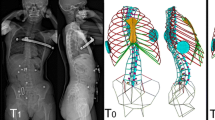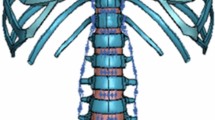Abstract
Study design
Retrospective validation study.
Objectives
To propose a method to evaluate, from a clinical standpoint, the ability of a finite-element model (FEM) of the trunk to simulate orthotic correction of spinal deformity and to apply it to validate a previously described FEM.
Summary of background data
Several FEMs of the scoliotic spine have been described in the literature. These models can prove useful in understanding the mechanisms of scoliosis progression and in optimizing its treatment, but their validation has often been lacking or incomplete.
Methods
Three-dimensional (3D) geometries of 10 patients before and during conservative treatment were reconstructed from biplanar radiographs. The effect of bracing was simulated by modeling displacements induced by the brace pads. Simulated clinical indices (Cobb angle, T1–T12 and T4–T12 kyphosis, L1–L5 lordosis, apical vertebral rotation, torsion, rib hump) and vertebral orientations and positions were compared to those measured in the patients’ 3D geometries. Results: Errors in clinical indices were of the same order of magnitude as the uncertainties due to 3D reconstruction; for instance, Cobb angle was simulated with a root mean square error of 5.7°, and rib hump error was 5.6°. Vertebral orientation was simulated with a root mean square error of 4.8° and vertebral position with an error of 2.5 mm.
Conclusions
The methodology proposed here allowed in-depth evaluation of subject-specific simulations, confirming that FEMs of the trunk have the potential to accurately simulate brace action. These promising results provide a basis for ongoing 3D model development, toward the design of more efficient orthoses.
Similar content being viewed by others
References
Dubousset J. [Idiopathic scoliosis. Definition—pathology—classification—etiology]. Bulletin de l’Academie nationale de medecine 1999;183:699–704.
Carman DL, Browne RH, Birch JG. Measurement of scoliosis and kyphosis radiographs. Intraobserver and interobserver variation. J Bone Joint Surg Am 1990;72:328–33.
Negrini S, Minozzi S, Bettany-Saltikov J, et al. Braces for idiopathic scoliosis in adolescents. Cochrane Database Syst Rev 2010;CD006850.
Nachemson AL, Peterson LE. Effectiveness of treatment with a brace in girls who have adolescent idiopathic scoliosis. A prospective, controlled study based on data from the brace study of the scoliosis research society. J Bone Joint Surg Am 1995;77:815–22.
Weinstein SL, Dolan LA, Wright JG, Dobbs MB. Effects of bracing in adolescents with idiopathic scoliosis. NEngl J Med 2013;369:1512–21.
Courvoisier A, Drevelle X, Vialle R, et al. 3D analysis of brace treatment in idiopathic scoliosis. Eur Spine J 2013;22:2449–55.
Wang W, Baran GR, Betz RR, et al. The use of finite element models to assist understanding and treatment for scoliosis: a review paper. Spine Deformity 2014;2:10–27.
Jalalian A, Gibson I, Tay EH. Computational biomechanical modeling of scoliotic spine: Challenges and opportunities. Spine Deformity 2013;1:401–11.
Wynarsky GT, Schultz AB. Optimization of skeletal configuration: studies of scoliosis correctionbiomechanics. JBiomeeh 1991;24:721–32.
Gignac D, Aubin CE, Dansereau J, Labelle H. Optimization method for 3D bracing correction of scoliosis using a finite element model. Eur Spine J 2000;9:185–90.
Clin J, Aubin C-E, Parent S, et al. Comparison of the biomechanical 3D efficiency of different brace designs for the treatment of scoliosis using a finite element model. Eur Spine J 2010;19:1169–78.
Perie D, Aubin CE, Petit Y, et al. Personalized biomechanical simulations of orthotic treatment in idiopathic scoliosis. Clin Biomech (Bristol, Avon) 2004;19:190–5.
Perie D, Aubin CE, Lacroix M, et al. Biomechanical modelling of orthotic treatment ofthe scoliotic spine including a detailed representation of the brace-torso interface. Med Biol Eng Comput 2004;42:339–44.
Chou WK, Liu CL, Liao YC, et al. Using finite element method to determine pad positions in a Boston brace for enhancing corrective effect on scoliotic spine: a preliminary analysis. J Med Biol Eng 2012;32:29–35.
Desbiens-Blais F, Clin J, Parent S, et al. New brace design combining CAD/CAM and biomechanical simulation for the treatment of adolescent idiopathic scoliosis. Clin Biomech 2012;27:999–1005.
Courvoisier A, Drevelle X, Dubousset J, Skalli W. Transverse plane 3D analysis of mild scoliosis. Eur Spine J 2013;22:2427–32.
Ilharreborde B, Dubousset J, Skalli W, Mazda K. Spinal penetration index assessment in adolescent idiopathic scoliosis using EOS low-dose biplanar stereoradiography. Eur Spine J 2013;22: 2438–44.
Jolivet E, Sandoz B, Laporte S, et al. Fast 3D reconstruction of the rib cage from biplanar radiographs. Med Biol Eng Comput 2010;48: 821–8.
Humbert L, De Guise JA, Aubert B, et al. 3D reconstruction of the spine from biplanar X-rays using parametric models based on transversal and longitudinal inferences. Med Eng Phys 2009;31:681–7.
Aubert B, Vergari C, Ilharreborde B, et al. 3D reconstruction of rib cage geometry from biplanar radiographs using a statistical parametric model approach. Computer Methods Biomech Biomed Eng; In press.
Aubert B, Vergari C, Ilharreborde B, Skalli W. Reconstruction ofthe rib cage geometric properties from biplanar radiographs. In: 48th Annual Meeting of the Scoliosis Research Society, Lyon (France), 2013.
Courvoisier A, Ilharreborde B, Constantinou B, et al. Evaluation of a three-dimensional reconstruction method of the rib cage of mild scoliotic patients. Spine Deformity 2013;1:321–7.
Descrimes JL, Aubin CE, Skalli W, et al. Introduction des facettes articulaires dans une modelisation par elements finis de la colonne vertébrale et du thorax scoliotique: Aspects mecaniques. Rachis 1995;7:301–14.
Aubin CE, Descrimes JL, Dansereau J, et al. [Geometrical modeling of the spine and the thorax for the biomechanical analysis of scoliotic deformities using the finite element method]. Ann Chir 1995;49: 749–61.
Lemosse D, Le Rue O, Diop A, et al. Characterization of the mechanical behaviour parameters of the costo-vertebral joint. Eur Spine J 1998;7:16–23.
Lafon Y, Lafage V, Dubousset J, Skalli W. Intraoperative threedimensional correction during rod rotation technique. Spine 2009;34:512–9.
Lafon Y, Lafage V, Steib JP, et al. In vivo distribution of spinal intervertebral stiffness based on clinical flexibility tests. Spine 2010;35: 186–93.
Pezowicz C, Glowacki M. The mechanical properties of human ribs in young adult. Acta Bioeng Biomech 2012;14:53–60.
Sandoz B, Badina A, Laporte S, et al. Quantitative geometric analysis of rib, costal cartilage and sternum from childhood to teenagehood. Med Biol Eng Comput 2013;51:971–9.
Steib JP, Dumas R, Mitton D, Skalli W. Surgical correction of scoliosis by in situ contouring: a detorsion analysis. Spine 2004;29: 193–9.
Fornasini P. The uncertainty in physical measurements: An introduction to data analysis in the physics laboratory. Springer Science; 2008.
Clin J, Aubin CE, Lalonde N, et al. A new method to include the gravitational forces in a finite element model of the scoliotic spine. Med Biol Eng Comput 2011;49:967–77.
Odermatt D, Mathieu PA, Beausejour M, et al. Electromyography of scoliotic patients treated with a brace. J Orthop Res 2003;21:931–6.
Portier L, Thibault A, Skalli W, et al. Approche d’une modelisation globale, tridimensionnelle par eéléements finis, de la colonne vertéebrale pour l’éetude de la scoliose. Rachis 1993;5:5.
Chazal J, Tanguy A, Bourges M, et al. Biomechanical properties of spinal ligaments and a histological study of the supraspinal ligament in traction. J Biomech 1985;18:167–76.
Author information
Authors and Affiliations
Corresponding author
Additional information
Author disclosures: none.
Rights and permissions
About this article
Cite this article
Vergari, C., Ribes, G., Aubert, B. et al. Evaluation of a Patient-Specific Finite-Element Model to Simulate Conservative Treatment in Adolescent Idiopathic Scoliosis. Spine Deform 3, 4–11 (2015). https://doi.org/10.1016/j.jspd.2014.06.014
Received:
Revised:
Accepted:
Published:
Issue Date:
DOI: https://doi.org/10.1016/j.jspd.2014.06.014




